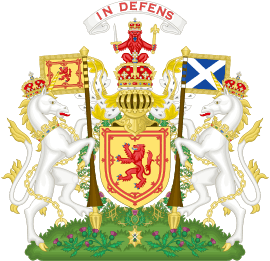Flag of Nova Scotia
 | |
| Proportion | 1:2 |
|---|---|
| Adopted | 1858 |

Created in 1858,[1] the flag of Nova Scotia is a banner of the coat of arms of Nova Scotia, which were granted to the Scottish colony by King Charles I in 1625.
The flag of the modern Canadian province, a blue saltire on a white field (background), is a simple figure-ground reversal of the flag of Scotland (a white saltire, Saint Andrew's cross, on a blue field), charged with an inescutcheon bearing the royal arms of Scotland, a gold shield with a red lion rampant surrounded by a loyal double tressure (a double border decorated with fleurs de lis).
The similarity to the Scottish flag reflects the province's name, which is Latin for "New Scotland". Nova Scotia was one of the few British colonies to be granted its own coat of arms, and the flag is the only one of the original Canadian provinces dating back to before confederation.
Despite continuous usage of the flag to represent Nova Scotia since 1858, the flag was only recognized by the provincial government of Nova Scotia as the official provincial flag in May 2013, through the Provincial Flag Act,[2] after an eleven-year-old girl researching a project realized that no one had recognized the flag officially in 155 years of usage.[3]
The flag is ranked #12 in the North American Vexillological Association's survey of North American state and provincial flags.[4]
 The flag of Nova Scotia.
The flag of Nova Scotia. The flag of Scotland.
The flag of Scotland.
 The arms of the Scottish colony of Nova Scotia, granted in 1625.
The arms of the Scottish colony of Nova Scotia, granted in 1625..png) The former flag of Nova Scotia (1868-1929).
The former flag of Nova Scotia (1868-1929).
See also
References
External links
- Arms and flag of Nova Scotia in the online Public Register of Arms, Flags and Badges